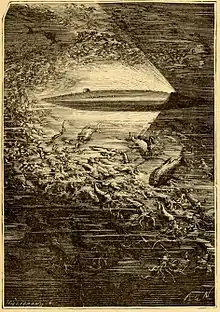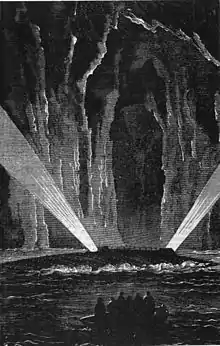Nautilus (fictional submarine)
Nautilus is the fictional submarine captained by Nemo featured in Jules Verne's novels Twenty Thousand Leagues Under the Sea (1870) and The Mysterious Island (1874). Verne named the Nautilus after Robert Fulton's real-life submarine Nautilus (1800).[1] For the design of the Nautilus Verne was inspired by the French Navy submarine Plongeur, a model of which he had seen at the 1867 Exposition Universelle, three years before writing his novel.[2]



Description
Nautilus is described by Verne as "a masterpiece containing masterpieces".[3] It is designed and commanded by Captain Nemo. Electricity provided by sodium/mercury batteries (with the sodium provided by extraction from seawater) is the craft's primary power source for propulsion and other services. The energy needed to extract the sodium is provided by coal mined from the sea floor.[4]
Nautilus is double-hulled,[5] and is further separated into water-tight compartments. Its top speed is 43 knots (50 mph).[4] In Captain Nemo's own words:
Here, Professor Aronnax, are the different dimensions of this boat now transporting you. It's a very long cylinder with conical ends. It noticeably takes the shape of a cigar, a shape already adopted in London for several projects of the same kind. The length of this cylinder from end to end is exactly seventy meters, and its maximum breadth of beam is eight meters. So it isn't quite built on the ten–to–one ratio of your high–speed steamers; but its lines are sufficiently long, and their tapering gradual enough, so that the displaced water easily slips past and poses no obstacle to the ship's movements. These two dimensions allow you to obtain, via a simple calculation, the surface area and volume of the Nautilus. Its surface area totals 1,011.45 square meters, its volume 1,507.2 cubic meters—which is tantamount to saying that when it's completely submerged, it displaces 1,500 cubic meters of water, or weighs 1,500 metric tons.[5]
Nautilus uses floodable tanks in order to adjust buoyancy and so control its depth. The pumps that evacuate these tanks of water are so powerful that they produce large jets of water when the vessel emerges rapidly from the surface of the water. This leads many early observers of Nautilus to believe that the vessel is some species of marine mammal, or perhaps a sea monster not yet known to science. To submerge deeply in a short time, Nautilus uses a technique called "hydroplaning", in which the vessel dives down at a steep angle.[5]
Nautilus supports a crew that gathers food from the sea.[6] Nautilus includes a galley for preparing these foods, which includes a machine that makes drinking water from seawater through distillation.[4] Nautilus is not able to refresh its air supply, so Captain Nemo designed it to do this by surfacing and exchanging stale air for fresh, much like a whale.[4] Nautilus is capable of extended voyages without refueling or otherwise restocking supplies. Its maximum dive time is around five days.
Much of the ship is decorated to standards of luxury that are unequalled in a seagoing vessel of the time. These include a library containing about twelve thousand books, with boxed collections of valuable oceanic specimens. The library is also filled with expensive paintings and other works of art.[7] Nautilus also features a lavish dining room[6] and even an organ that Captain Nemo uses to entertain himself in the evening. By comparison, Nemo's personal quarters are very sparsely furnished, but do feature duplicates of the bridge instruments, so that the captain can keep track of the vessel without being present on the bridge.[7] These amenities however, are only available to Nemo, Professor Aronnax, and his companions.
From her attacks on ships, using a ramming prow to puncture target vessels below the waterline, the world thinks it a sea monster, but later identifies it as an underwater vessel capable of great destructive power, after Abraham Lincoln is attacked and Ned Land strikes the metallic surface of Nautilus with his harpoon.
Its parts are built to order by companies including Creusot and Cail & Co. in France, Pen & Co. and Laird's in England, Scott's in Scotland, Krupp in Prussia, the Motala workshops in Sweden, and Hart Bros. in the United States. Then they are assembled by Nemo's men on a desert island.[5] Nautilus returned to this island, where Nemo later helped castaways in the novel The Mysterious Island. After Nemo dies on board, the volcanic island erupts, entombing the Captain and Nautilus for eternity.
Appearances
Beside their original appearances in Twenty Thousand Leagues Under the Sea and The Mysterious Island, Nautilus and Captain Nemo have appeared in numerous other works.
- In the 1954 film adaptation of the first novel and in The Return of Captain Nemo, it is suggested that Nautilus is powered by nuclear energy (discovered by Nemo himself), and that Nemo uses the same energy to destroy Vulcania, Nautilus's base island. This version also appears in the video game Epic Mickey, under the name of Notilus.
- The comic book The League of Extraordinary Gentlemen and its film adaptation feature a much larger version of Nautilus; The League of Extraordinary Gentlemen: The Black Dossier states that it is a second, larger submarine built after the destruction of the first one from Verne's novels. This version features a design evoking a squid attacking a whale; the squid section, which has functional tentacles, can be detached as shown in the cross-section from The Black Dossier. The version in the film adaptation has a more straightforward appearance of a long, thin silver submarine, albeit of massive proportions, equipped with a sharpened front end and missile launchers, narrow enough to comfortably travel through the canals of Venice.
- Nautilus can also be seen at Disneyland Paris and Tokyo Disneysea, the one in Paris being a walk-through, while the Disneysea version is a static prop in a lagoon that can't be accessed by the public.
- In Kevin J. Anderson's Captain Nemo: The Fantastic History of a Dark Genius, Nautilus appears as a real submarine, apparently cigar-shaped like the one from the novel, built by Nemo for the Ottoman Empire.
- In Warren Ellis's Planetary series, Elijah Snow hides himself aboard the Nautilus, which has been captured by villains The Four.
- In the book Here, There Be Dragons (2006) by James A. Owen. Nemo and Nautilus, which is also called the Yellow Dragon, both appear.
- In the MMORPG MapleStory, Nautilus is a submarine that looks like a whale with a skull attached to the front. In other words, it is also the town of pirates.
- In Valhalla Rising, by Clive Cussler, Nemo and Nautilus are discovered by a researcher and stored in a hidden cave as his private research lab. Its propulsion in the novel is described as a Magneto-hydrodynamic drive.
- In Nadia: The Secret of Blue Water, a steampunk-themed anime set in 1889, Nautilus is an ancient Atlantean war machine. It is approximately 150 metres in length and filled with scientific marvels, such as electricity, indoor plumbing and a "particle annihilation engine" as its power source.
- In the Japanese anime feature film Kaitei Daisensō: Ai no 20,000 Miles (Japanese: 海底大戦争 愛の20000マイル, "The Great Navy Battle: 20,000 Miles of Love" (1981)) Captain Nemo plans to use the Nautilus to confront humanoid aliens who have invaded Earth.
- In Journey 2: The Mysterious Island 2012, the main characters locate Nautilus and use it to escape the sinking island, kick-starting its dead batteries with power from a massive electric eel.
- In the 1969 film Captain Nemo and the Underwater City, Nautilus and its sister ship Nautilus II are depicted as industrialised stingray-like vessels, flattened with pronounced tumblehomes supporting rounded deckhouses. Each has a heavy girderwork tail, at the tip of which twin rudders and diving planes are mounted.
- The Nautilus and Nemo also appear in Once Upon A Time, Season 6, with the ship hewing closely to its design from the 1954 film.
- In the Japanese otome visual novel, Code Realize- Guardian of Rebirth, the airship fortress designed by the scientist Nemo is named Nautilus.
Other Verne submarines
Submarines feature in some other of Verne's works. In the 1896 novel Facing the Flag, the pirate Ker Karraje uses an unnamed submarine that acts both as a tug to his schooner Ebba and for ramming and destroying ships which are the targets of his piracy. The same book also features HMS Sword, a small Royal Navy experimental submarine which is sunk after a valiant but unequal struggle with the pirate submarine. In the book The Master of the World, Robur's secondary vehicle, Terror, is a strange flying machine with submarine, automobile and speedboat capabilities. It briefly eludes naval forces on the Great Lakes by diving.
Images
 Captain Nemo and Professor Aronnax discussing the plans of Nautilus.
Captain Nemo and Professor Aronnax discussing the plans of Nautilus. The Grand Salon of Nautilus.
The Grand Salon of Nautilus. Captain Nemo's room aboard Nautilus.
Captain Nemo's room aboard Nautilus. The library of Nautilus.
The library of Nautilus. Engine room of Nautilus.
Engine room of Nautilus. Main window of Nautilus.
Main window of Nautilus. The silhouette of Nautilus in the distance.
The silhouette of Nautilus in the distance.
See also
Notes
- Skrabec, Quentin R. (2005). The Metallurgic Age: The Victorian Flowering of Invention and Industrial Science (revised ed.). Jefferson NC: McFarland. p. 44. ISBN 9781476611136. Retrieved 23 February 2017.
- Notice at the Musée de la Marine, Rochefort
- Verne, Jules. The Mysterious Island. Translated by Frederick Paul Walter – via Wikisource.
- Verne, Jules. 20,000 Leagues Under the Seas. Translated by Frederick Paul Walter – via Wikisource.
- Verne, Jules. 20,000 Leagues Under the Seas. Translated by Frederick Paul Walter. ISBN 978-1-4384-3238-0 – via Wikisource.
- Verne, Jules. 20,000 Leagues Under the Seas. Translated by Frederick Paul Walter. ISBN 978-1-4384-3238-0 – via Wikisource.
- Verne, Jules. 20,000 Leagues Under the Seas. Translated by Frederick Paul Walter. ISBN 978-1-4384-3238-0 – via Wikisource.
References
Jules Verne's text in 20,000 Leagues under the Sea provides a great deal of information about Nautilus as discussed on this page: Jules Verne's Nautilus. Many artists and ordinary folk have envisioned over the decades their own interpretations of Nautilus: A Catalog of Nautilus Designs